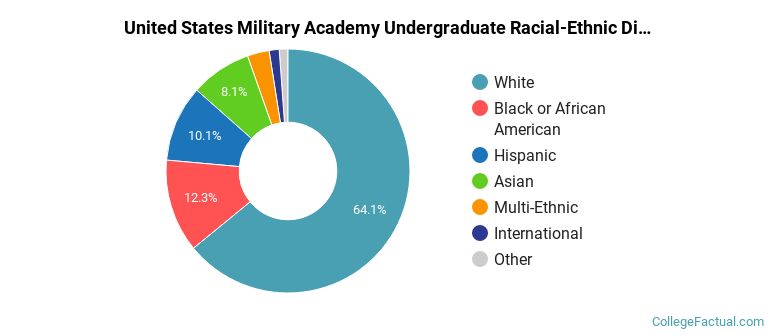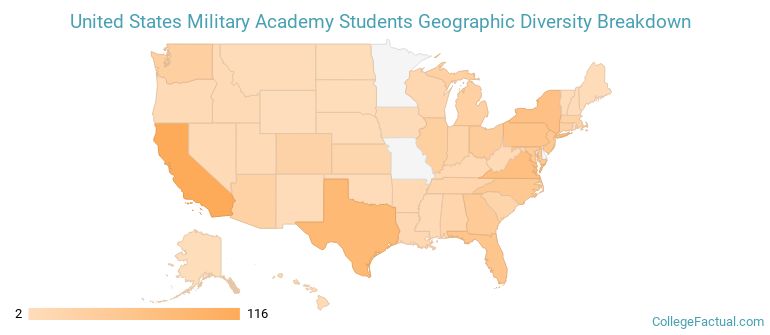 by our College Data Analytics Team
by our College Data Analytics TeamWest Point total enrollment is approximately 4,536 students.
Male/Female Breakdown of Undergraduates
The full-time West Point undergraduate population is made up of 24% women, and 76% men.

For the gender breakdown for all students, go here.
West Point Racial/Ethnic Breakdown of Undergraduates

| Race/Ethnicity | Number |
|---|---|
| White | 2,817 |
| Black or African American | 579 |
| Hispanic | 540 |
| Asian | 351 |
| Multi-Ethnic | 118 |
| International | 58 |
| Unknown | 29 |
| Native Hawaiian or Pacific Islander | 10 |
See racial/ethnic breakdown for all students.

| Race/Ethnicity | Number |
|---|---|
| White | 2,817 |
| Black or African American | 579 |
| Hispanic | 540 |
| Asian | 351 |
| Multi-Ethnic | 118 |
| International | 58 |
| Unknown | 29 |
| Native Hawaiian or Pacific Islander | 10 |

There are approximately 1,074 female students and 3,462 male students at West Point.
West Point ranks 10 out of 2,183 when it comes to geographic diversity.
93.37% of West Point students come from out of state, and 1.11% come from out of the country.

The undergraduate student body is split among 49 states (may include Washington D.C.). Click on the map for more detail.

| State | Amount |
|---|---|
| California | 116 |
| Texas | 85 |
| Virginia | 71 |
| New York | 67 |
| Pennsylvania | 60 |
Students from 32 countries are represented at this school, with the majority of the international students coming from Mongolia, Nigeria, and Pakistan.
Learn more about international students at West Point.
A traditional college student is defined as being between the ages of 18-21. At West Point, 86.15% of students fall into that category, compared to the national average of 60%.

| Student Age Group | Amount |
|---|---|
| 20-21 | 1,955 |
| 18-19 | 1,914 |
| 22-24 | 535 |
| 25-29 | 35 |
| 30-34 | 0 |
| 35 and over | 0 |
| Under 18 | 0 |
Footnotes
*The racial-ethnic minorities count is calculated by taking the total number of students and subtracting white students, international students, and students whose race/ethnicity was unknown. This number is then divided by the total number of students at the school to obtain the racial-ethnic minorities percentage.
References
Department of Homeland Security Citizenship and Immigration Services
Find out how College Factual created their Diversity Rankings.